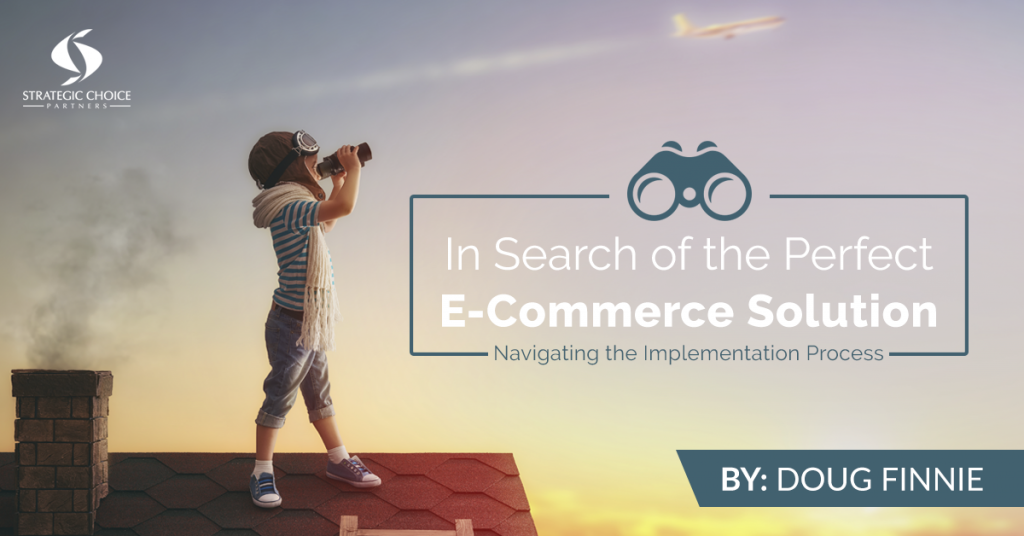This article is part of an ongoing series by Doug Finnie, titled “In Search of the Perfect E-Commerce Solution Series.” View the rest of the series HERE.
Continuing with the fourth part of a five-part series on, “In Search of the Perfect Software Solution,” where we have been discussing the different phases of searching for and implementing software solutions. The fourth part will cover the software implementation phase.
So far, we have done our homework, identified software requirements and functionality needed, selected the software vendor to partner with and have taken the giant step of signing the contract to buy or license the software itself. Now what? Below we will help you understand the key milestones of the implementation process. Each company does it a little differently and adapts to processes that work best for them based on size, project resources and budget.
Now you have to navigate the river of implementation. Your company will find yourself facing rapids, whirlpools and calm waters, and you can face them each and every day or sometimes just one or none at all. Just remember no matter what happens–Don’t panic. Work each and every day to determine and manage the health of the implementation by understanding where you are, what needs to be done and what’s next.
The basic key milestones of an implementation process are typically (differing based on the size of your project):
- Project Kick-Off
- Environmental Set Up
- Configuration & Development
- Migration of Data
- Testing & User Acceptance Testing
- Launch
Each of the above milestones can be a subject blog by themselves, but for now, we will briefly touch on them individually to provide a general understanding of each one.
The Project Kick-Off
The Project Kick-Off is a very exciting time where both teams are eager to begin. Teams’ are optimistic and confident in the project’s success. This milestone is where you sit down and review your functional requirements that should already be documented with your software partner. Some vendors require that you follow their format and process in documenting requirements. Others don’t have a format requirement.
How you document is not as critical as what is documented. This allows you to review what you need and it also allows your software partner one last chance to verify the scope and validate their budget of time and cost.
At this point, you must review the costs and budgets and make sure you and your partner are both okay with the plan to move forward. Although you can typically cancel or suspend an implementation project once you begin, it usually ends up with frustration and unrecoverable costs if you don’t take the time to verify.
“Ensure the kick-off phase includes a clear and detailed project plan that outlines all milestones, tasks, owners of tasks and dates.” – Click to Tweet
This will be your ‘map’ as you begin the river journey. If this is incorrect, you may end up at the end of your journey with no money, no software and a lot of regret.
Also, you will want to include any training that may be required to prepare you to use the software or software tools in order to complete your implementation tasks. If the training is done remotely, be sure to ask for the training to be recorded so you have a recording to reference in the future.
Environmental Set Up
Let’s assume you are licensing a Software as a Solution (SaaS) model, this phase involves the software partner setting up the servers and databases within their hosted environment to build your system. Often times, this is done in parallel with the Kick-Off phase to save time. The software partner will require key facts such as order history volumes, user volumes and peak season characteristics so that they can determine the size and power of the server and database environment needed to handle the user base.
If you are purchasing your own software and will host it on your own servers, you will need to verify what equipment is needed and where it is to be installed. Who is to install it? Will it be cloud based or in your own data center and the architecture needed? If you don’t have internal resources, you will need to hire or contract with IT resources who are experts in this area to ensure your architecture is defined and installed correctly.
It is critical that you have the correct resources to do this phase because it can cost you a significant amount of money if done incorrectly. Strategic Choice Partners can assist you with this if you do not have the resources available.
Configuration and Development
Configuration and Development is the building phase. Your partner will be busy setting up the system’s configuration settings based on the requirements they were given. This is also the phase where custom development will be done if system enhancements are required.
Often time, business’ get worried because the project teams seem to go ‘silent’ during this phase. That is anything but the truth. This is the busiest time for the technical teams. If you think of building a house, this is the framing phase. Depending on the software partner, there may be an opportunity for the business to participate in this phase. As software platforms progress, the focus has been to put the ‘power’ in the business’ hands and make sure the platforms are user-friendly, thereby allowing business users to configure functionality on their own without the help of a programmer. Partaking in the configuration phase will enable you to be more self-sufficient once the platform is turned over at launch.
It is important that during this phase the project plan and requirements and development are managed closely. This phase can become frustrating at times because this is where “misses” are discovered, meaning required or desired functionality.
The business will be faced with a decision to postpone adding the functionality or include it and risk increasing costs and launch timelines. It is almost a guarantee that something will be missed so don’t get too frustrated. Require the project team to provide frequent and thorough updates during this phase to lessen the fears and risks.
The build phase is a moderate to high-risk phase if not managed appropriately due to the technical teams sometimes misinterpreting requirements. Or incorrectly configuring something or actually building out an enhancement incorrectly that can set back the entire project. To ensure successful completion of this phase, you should have the appropriate technical support on staff to assist in managing the communication between the business and the technical teams.
Migration of Data
Migration of Data is one of the highest risk areas of the project. If your project requires migrating from one system to another, then relationship management becomes a critical component. The current software vendor will have to be notified that their services will no longer be needed, yet they will need to provide historical user data to be loaded into the new system. That process needs to be managed professionally by focusing on the tasks at hand and understanding your rights under the current software contract.
Data and the rights to that data should be clearly outlined in the current provider’s contract. The contract should outline your rights to a file or files that contain the necessary historical data. Keep in mind the format in which they provide you the data will have a direct impact on the timing and success of uploading the data into the new system. If the contract does not specify the format then you may need to negotiate on the new software partner’s behalf to get the data in the correct format.
Typically, most software vendors are pretty accommodating. Be aware that the process of extracting data and providing files to the new partner is often billable on a time and materials basis (from both software vendors). The existing and new software vendors will bill you for each time they have to extract, upload and massage data.
Testing and User Acceptance Testing
Testing and User Acceptance Testing is the exciting phase. This is where you get to test drive the new system and train the business on how to use the system. Prior to this phase, you need to work with your partner and develop a thorough test plan. The plan needs to include steps to test the functionality, navigational and architectural design of the system. The type of plan and the amount of detail to include in the plan is dictated by the qualitative and quantitative demands placed on the team by the business.
Obviously, it is critical that the system be functional and the content correct, but does it have to be 100% perfect at launch? That is unobtainable unless you have millions of dollars and a significant build timeline. Focus on the critical functionality and design. There are many different test plan templates that can be used and downloaded from the internet. You should allow a minimum of four weeks for this phase.
It is important to ensure that a formal regression test plan be followed which requires the project team to test the system end to end after each change, enhancement or fix that is done on the system.
Launch
Launch phase should be a time for celebration. If each of the prior phases were completed successfully, this phase should go smooth. When you are ready to launch, be sure to create a marketing and communication strategy for your end users.
Prior to turning on the system, make sure you have identified a launch plan that includes specific criteria that must be met prior to a ‘go’ decision. The criteria should include functional and system performance standards such as transactional, financial, shipping and reporting requirements. Additionally, it is recommended that you have a launch team that has input to deciding when and if the system should be launched and the members of that committee should be: head of finance, operations, marketing and IT. Each member should have a yes or no vote, and they should be involved throughout the project up to and including launch.
During launch phase, the business and software partner should work together to identify a process to track any reported issues, prioritize them and resolve them as soon as possible. The project leaders have to ensure open communication including frequent updates as to the status of the launch. The focus has to be on issue resolution and ensuring correct information is being disseminated so that negative rumors do not curtail the success of your launch.
Launching a system can be fun. Make a decision to enjoy it!
Related Resources
About Doug Finnie
 Doug has over thirty years of management experience in the Technology, Direct Sales and Banking industries holding roles in direct sales organizations such as Origami Owl and Gold Canyon Candles and in other industries such as software development and fulfillment and logistics. As an accomplished CIO his specialties include working with business leaders in defining technology strategies, technical contract and due diligence assessments, project management and systems implementation and migrations. Doug has previously served on the DSA Technology Advisory Council.
Doug has over thirty years of management experience in the Technology, Direct Sales and Banking industries holding roles in direct sales organizations such as Origami Owl and Gold Canyon Candles and in other industries such as software development and fulfillment and logistics. As an accomplished CIO his specialties include working with business leaders in defining technology strategies, technical contract and due diligence assessments, project management and systems implementation and migrations. Doug has previously served on the DSA Technology Advisory Council.
Learn more about Doug on his bio page, and contact us at info@strategicchoicepartners.com if you’d like to discuss how Doug and SCP can help your company.


Leave a Reply